Grooves & Patterns 1
Ask a question about this subject?
Post a question direct to our forums and get mailed when a reply is added!
There are 34 viewer comments posted to this page - Read
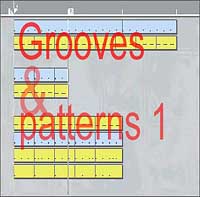
Author: admin
Date: 04-Oct-01
Well, there is so many articles all over the www about making dance music - Magazines like FM have done series of articles about creating different styles.... but to my mind that creates a simple 'copying by numbers' results... it says "Yes, here is how to make a sauce to this recipe", but doesn't say - "This is the basis to make a sauce from which any sauce can be made"
The newbie entering this crazy world of dancemusic riddims is bound to be confused - So many styles!.... none of them sound the same, how do I go about making my grooves, basslines, patterns & beats etc?..... There has to be a basis - So this article is about that - The Basis of it all....
Now If you read the Drum Article ("DRUM STUFF - ONE"), there's a little history in there, showing just how much non-western influence there is in dance styles of grooves. It is inevitable of course, and where do we look for these influences?.. Well, we look to S.America and it's latin music's, and to Africa, and to any music's carrying crossover from these.... Of course it sounds crass to say that, surely everyone will know the influence in their mind, but how do you translate that into your sequencer & music composing s/w ??...
Now in the west we are brought up on a diet of music done in 4 & 2 time... all the pop music in the charts is almost exclusively in 4/4 time, western church music is mostly in 4/4 and 2/4 time or 2/2 time, it's an on-the-beat cultural thing.... Conversely in Latin & African & eastern styled beats there is a prevelennce of 3 time..... or 3 time cross-over.... I'm not going to write all that influence again here... read the "DRUM STUFF - ONE" article, but suffice to say, Latin music carries a strong 3 time feel... African music carries a strong 3-time feel, arab music carries a strong 3-time feel.... 3-time is prevelent as a crossover anywhere where anyone from outside europe or with sufficient non-european influence...
SPAIN - FLAMENCO/BALAERIC
One of the first examples of this crossover is in Latin music... Spain. - Spain as you know was invaded and occupied by 'the moors' as they were known, the whole interaction between west (Christian) & East (Islam) has waged for centuries... Spanish music thus was irrevocably influenced by arabic 3-time music patterns... and as a consequence after the Arabs were chased out of Spain, the arab population or arab descended population made it's own distinct culture alongside Christian western culture and carried this forward to the present day with 'Flamenco'. Flamenco is strongest the further south you go in Spain, as the south was the main influence as it was invaded by Arabs, and the north was not...
Now, Flamenco as with all Balearic music is as a consequence influenced by arabic music... 3-time.... the thing is tho, that 3-time & 4-time combine to make patterns of structure which resolve to 3 AND 4... That is 12, 16, etc...
USA - BLUES
Another place where this 3-time crossover revealed itself in modern culture is in the Blues and related music of especialy the Southern United States... African's dragged over from home to work as slave labour brought their cultural 3-time patterns and again we see 3-time strongly figured in Blues & related styles. Evever wondered why they call them '12-bar Blues' ?.. or '16-bar blues' ?... cos they are divisions of 3-time again.
CELTIC MUSIC
Well Celtic music also has a 3-time influence... hmm.... wether this has anything to do with folklore about the origins of the celtic church I dunno.... but anyways there is 3-time also in that so we'll mention it here too.
LATIN MUSIC
South America was populated by many Africans and of course the Spanish too, resulting in probably the richest diversity of different 3/4 crossover music's of any Territory.....
WEST INDIES - JAMAICA
All the West Indies offer strong beats, but Jamaica being the main island on the slave route and being used and established as a 'holding camp' for slave traders and then the whole sugar industry spreading out aroiund the islands..... Jamaica is a rich melting pot of cultures, the results of this crossover is again a rich 3-time 4-time crossover which reveals itself in early reggea & now is the main beat of Dancehall music....
SO WHAT??
So.... familiarising oneself with these styles & their forms and feels & patterns is a great way to start, but also the way we work with our sequencer also makes a difference. We have to learn to 'count differently' from the way our ears have been sub-conciously trained over decades of listening to a predominantly 4/4 music feel... Often when 3-time is inserted into 4-time music we don't even see it or hear it cos it is well disguised is some styles such as with producers like Timbaland & with much recent RnB music such as even commercial stuff like Destiny's Child etc.... So let's look at the way we use that sequencer grid, and how we can work with it to reveal a new richness of feels, grooves and beats.....
SETTING UP- FOR THIS ARTICLE
download the midifile to accompany this page
It'll look like this when you open it in VST, but for the other sequencers the bit that matters is the music parts which will all look similar...
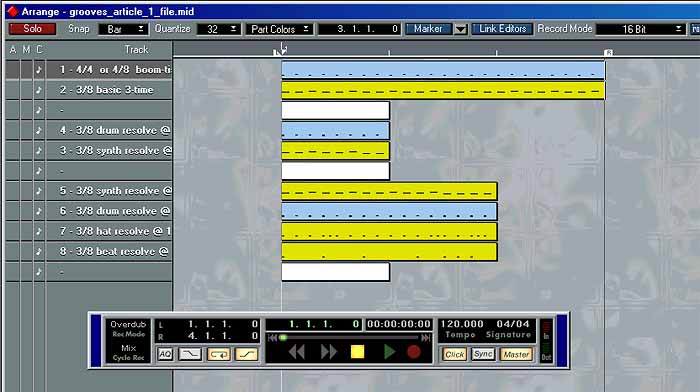
The midifile opens set to 4/4 Time-signature and usually set to 120bpm. - The L/R Locators are set to Loop 3 bars of 4/4... To follow this page there is a few things to setup first...
Once you've opend the file in your sequencer, setup your basic kik, snare & hat GM kit on a drum soft plugin like LM9 or whatever, and also open a basic s/w mono synth such as Neon or ES-1 in logic etc... or if you use outboard only, set it up so the drums play on channel_10 tracks and a mono synth on channel_13 for all the synth parts... assign your track midi outputs to external or plugin synth, then mute all the tracks....
Ok... once all that is setup we first need to chop up the music-part bits on the screen so that they are seperated into single bars of the various time-signatures to match the Article...
Make sure your SNAP or Quantise feature is set to BAR or WHOLE because we only want to work in full-bar resolutions when we chop up the parts into Bar-sized chunks
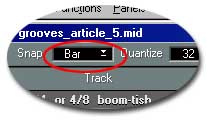
So first with the Time-Signature set at 4/4, chop up the 3 bar part on Track_1 - (1 - 4/4 or 4/8 boom-tish)... chop it into three 1_Bar sections... like this...

Now change the Time-Signature to 3/8... and chop up the part on Track_2 - (2 - 3/8 basic 3-time)... chop it up into eight 1_bar sections... like this...
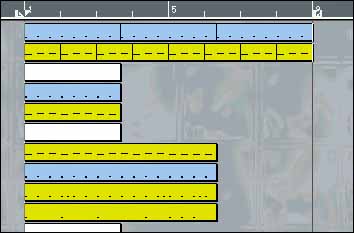
Now set the Time-Signature back to 4/4, and move the RIGHT Loop marker so the 4/4 now loops round Bars 1 & 2... like this...
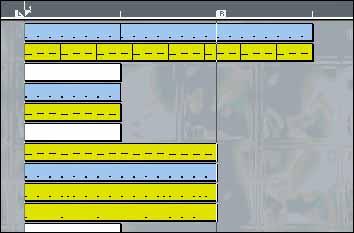
Now set the Time-Signature back to 3/8 & chop up the rest of the parts on Tracks 3, 4, 5, 6, 7 & 8.... (remember the white/blank tracks are seperators, all the tracks are numbered before the title)
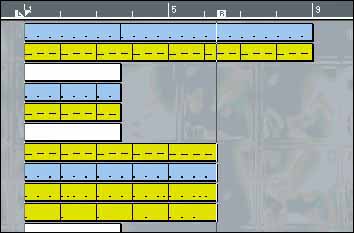
THE SEQUENCER GRID - 4/4 TIME
Ok... once you 'feel' these beats & grooves you can actualy play them live with your fingers on keys, but for now we work in step-time, inputting the notes on a grid, and this can teach us alot from which we can learn and then familiarise ourselves enuff to feel the grooves and know them inside us....
we'll start off by working with the first two Tracks of the midifile.... So, set a 4/4 Time-Signature on the Transport bar...

Now move the Right Locator so the Loop is just the first single 4/4 'boom-tish' beat on Track_1... it should look like this...
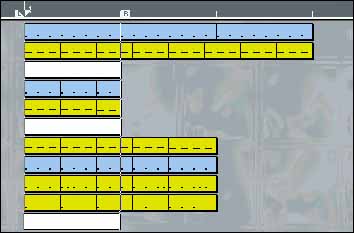
Double-Click on the first pattern at the top on Track_1 - (1 - 4/4 or 4/8 boom-tish) - and this is the resulting look of the grid.... Hit play on the sequencer and you hear the simple 'boom-tish' beat looping in 1_bar between the locators...

Ok... With the Time-Signature set to 4/4, we have a simple basic 130 BPM 'boom-tish' pattern which we can use as a basis for our beats. Most people start with a feel like this cos it establishes the single bar of 4/4 beat - Inside the pattern we have 4 beats marked 1,2,3,4 - and the kik is ON the beat, and the hat 'tish' is OFF the beat, sitting exactly in the middle between the kik 'boom' beats... simple & easy-peasey......
THE SEQUENCER GRID - 4/8 TIME
hmmm..... ok.. let's look at that beat again... I think the secret to most dance music is that it can be grooved to in two different speeds, and you'll notice this the most in styles where the cross-over exists - That is Jungle & Drum & Bass, Dancehall & RnB styles.... So let's look at the exact same pattern in 4/8 instead of 4/4... Go to the transport bar and change the setting of the time-signature to 4/8... this will give us a beat of 4 beats devided into 8 segments rather than 4 beats devided into 4 segments... do it...

Ok... now let's look at the same 'boom-tish' beat composed in 4/4, but now viewed as 4/8 on the grid...

Hmmm... we have the same beat, but now it seems to be spread over 2 bars... We have in effect doubled the beats from 4 to 8... so now instead of the 'tish' hat sitting between the kiks of the offbeat, we have 8 steps and the 'boom' kik's and the 'tish' hat sit each on their own beat with a clear grid-marker to show the position. Audibly everything is the same sound beat.... But switch on the Metronome, and the beat has doubled in metronome 'bleeps' - it is now counting 8 beats between cycles instead of 4.... hmmm.... Let's look at the two patterns together...
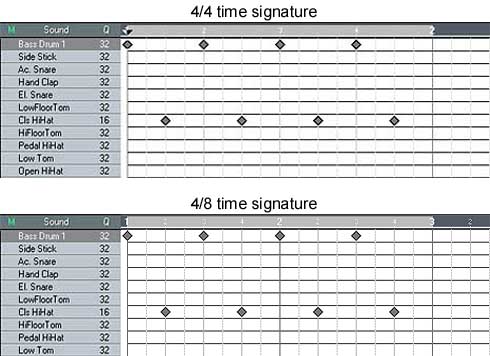
Interesting eh?.... All this does is give us a new way to look at things, BUT also makes us HEAR our pattern's 'in-between' beats... now we hear with the metronome the 8 beats being counted so that our hats fall on a beat instead of in-between a beat... no difference is made to the tempo or the groove, it is simply easier to see the divisions of beats by doubling the time-signature.... This is important when we start to work outside of 4/4 patterns.....
THE SEQUENCER GRID - 3/8 TIME
Ok... Let's now change the Time-Signature to 3/8 - a 3-time beat.... Set the transport-bar like this....

Ok.. now the grid looks like this....

Let's compare this 3/8 grid with the 4/4 grid...
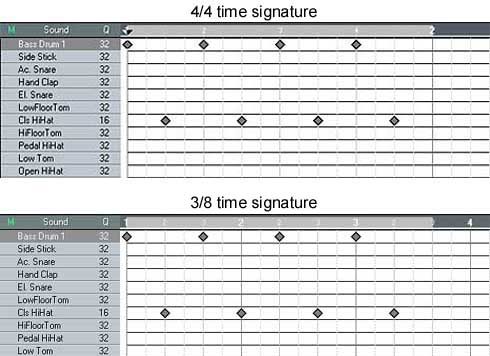
It's quite hard to see what's happening isn't it!... and if you set your Time-Signature to 3/4 and switch on the metronome it is also quite hard to hear what is happening... It's easier to hear if you set the metronome to 3/8
Now let's compare the 3/8 to a 4/8 ...
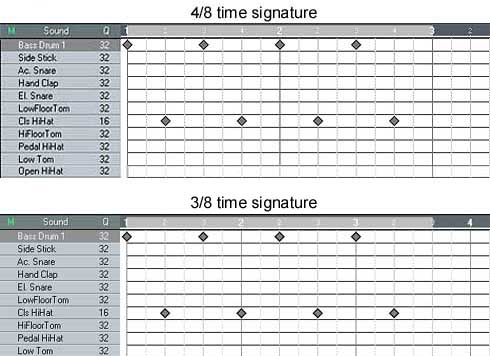
Ok with the Time-Signature set to 3/8, and still with only Track_1 open playing the drums, switch on the Metronome and listen now!!.... You should hear quite clearly that the metronome is counting in double-time, it is counting 8th's now... you can hear both the 3/8 metronome beat and the 4/4 (or 4/8) 'boom-tish' beat....
If you follow the kik-drum beats ('boom') on the grid you CAN count: '1,2,3,4' - but the metronome is counting over that in 3/8... it is counting: '1,2,3, 1,2,3, 1,2' - aha!!... Yup it is counting in 3-time (3/8) and because we started with a 4/4 pattern and set our L/R Locators to bar_1.00 & bar_2.00 to get 4 beats to a bar, now we have shifted the Time-Signature to 3/8, we still have our 4/4 markers setup for L/R on a 4-time pattern lemgth... If we double up from 4/4 to 4/8 the L/R markers still groups around resolutions of 2... so in 4/4 we see 4 beats & hear 4 beats from the metronome - In 4/8 we see 8 beats & hear 8 beats from the metronome... BUT now we have shifted to 3/8.... still counting in 8's at double time as it did in 4/8, BUT now the 3/8 want's to resolve to groups of 3 beats... But the L/R markers are still set for 4/4 or 4/8 beat length, so the 3/8 has to resolve it's loop without completing the last count of 3...
So the 3/8 overlay Time-Signature can't resolve at a 4/4 or 4/8 L/R marker.... so it counts: '1,2,3, 1,2,3, 1,2' - making a TOTAL of 8 beats to match the 4/4 or 4/8 derived L/R loop markers....hmmm.... interesting eh!
RESOLVING THE ISSUE
For this bit, first delete the empty music parts on the Blank seperator tracks.... The set the Metronome back to 4/4 ... The page should look now something like this....

hmmmm.. Ok, so how the hell do we resolve a 4/4 track with 3-time patterns??.. Obviously we need to resolve at any position in the track or groove where 3 & 4 mathmaticaly meet... so divisions of 3 & 4 is the place... So, anywhere where the 4/4 patterns are multiples of 3, this will be where the 3/4 beats resolve to multiples of 4...
You can see in this grid image how many bars it takes before a 3-time pattern will resolve with a 4-time pattern - it takes 3 bars of 4/4 to = 8 patterns of 3/4 - 3 bars of 4/4 is the shortest length into which 3/8 multiple bars will fit and resolve around in a perfect loop...
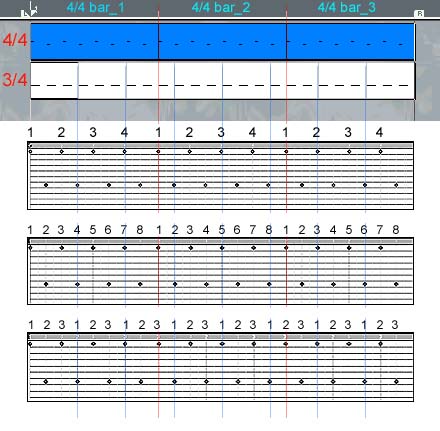
Therefore.....
- 3 bars of 4/4 to = 8 patterns of 3/4
- 6 bars of 4/4 to = 16 patterns of 3/4
- 12 bars of 4/4 to = 32 patterns of 3/4
- 24 bars of 4/4 to = 64 patterns of 3/4
Obviously, this means that tracks done with totally resolving 3-time patterns, must break at intervals of 3's - different to normal working in 4's where we change at bar 17 (after the last 16th bar), or at bar 33, or bar 65 etc etc... always we start the bar after blocks of previous 4's, 8's or 16's or 32 bars etc.... So again, if you want 3-time based patterns to work thru a track always resolving to end and start at breaks or bridge sections or rolls etc etc whilst at the same time you conciously are counting the 3-time pattern then you must resolve at bars which are multiples of the blocks of 8 x 3-time bars.
However, if you want to overlay a 3-time pattern FEEL over a 4/4 or 4/8 based beat and resolve everything to go with that beat, then you can count in double-time and resolve it with a new groove... This new groove born of the crossover of 3 & 4 time, is the basis of many ethnic styles using a 3/4 crossover feel as well as RnB, jungle & drum & bass, dancehall, underground trance and especialy ambient styles etc etc... and here's how you do it...
COUNTING 3/4's IN EIGHTS
Well that's why I wanted you to get into working in 4/8 sometimes because it get's you to SEE visualy more of that double-time 8th count beat overlaying the 4/4... once we count in that time instead of 1, 2, 3, 4, then the 3-time overaly becomes a new groove.
Put your sequencer with the 'Boom-tish' 4/4 beat into 3/8 time instead of 3/4 time and it all is easy to hear... The L/R loop markers will stay the same relative to the 4/4 bars of 'boom-tish', but new divisions will appear between the markers when you shift it to 3/8... like this....
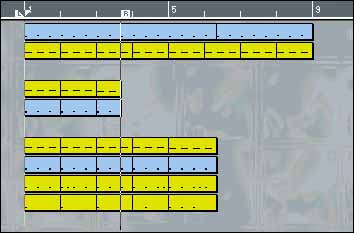
So now we are listening to a 4/4 or 4/8 'boom-tish' basic 4-time beat... and the metronome is counting around in a 3/8 loop....
1,2,3, 1,2,3 1,2 - 1,2,3, 1,2,3, 1,2
Each of these 3 + 3 + 2 = 8 beats... so the bars resolve around at 4/8 bar markers.
That: 1,2,3, 1,2,3, 1,2 - 1,2,3, 1,2,3, 1,2 count is the basis for your drum & bass, jungle, dancehall etc. Also we can use it as a template to get RnB pattern crossovers...
CROSSOVER - RESOLVE AT 8 BEATS - (Track_3 & 4)
Ok, all we have done so far is LOOK & LISTEN to a 3/8, 3-time metronome playing over a 4/4 'boom-tish' or 4/8 'boom-tish' beat.... Now we need to merge the two feels....
Keep the 'Boom-Tish' running on Track_1, and open up Track_3 - (3 - 3/8 synth resolve @ 8)
The L/R loop markers are still set at 1 Bar apart when the Time-Signtaure is set to 4/4... But the Time-Sig' is now set to 3/8.... See how The RIGHT Marker chops off the third beat of the 3rd bar of the Track_3?

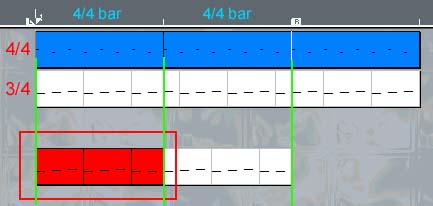
We can see how when working with the 3/8 pattern as an overlay on 4/4 or 4/8, it resolves at 8 beats whilst we still have the L/R Locators set to a 4/4 or 4/8 bar length....
Ok, with the Track_3 - (3 - 3/8 synth resolve @ 8) - running over the 'boom-tish', you can hear the emphasis even stronger... Turn off the metronome, and with Track_1 & Track_3 playing, spend some time switching the metronome In & OUT and changing the Time-signature between 4/4, 4/8 & 3/8 & 3/4... check it out... listen to it without the metrnome too...
ok.. nothing too amazing you might think but that's the crossover... Now let's make a beat to fit it.
Close down Track_1 (4/4 'boom-tish' beat), and open Track_4, (4 - 3/8 drum resolve @ 8).
Ok... that is a basic feel found in many music's from all round the world from Flamenco to Samba... and Dancehall!
CROSSOVER - RESOLVE AT 16 BEATS - (Track_5 & 6)
So - resolving at 8's when in 3/8 we count: 1,2,3, 1,2,3, 1,2 - - But we can count MORE of the 3's before the ending 2-beats of notes...
Now we are going to resolve at 16 beats which means that'll equal 2 x 4/4 bars = 16 beats.

Set your metronome & Time-Signature to 4/4 again.... Then
Set your L/R Locators two bars apart.... Like this...
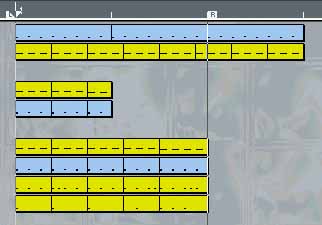
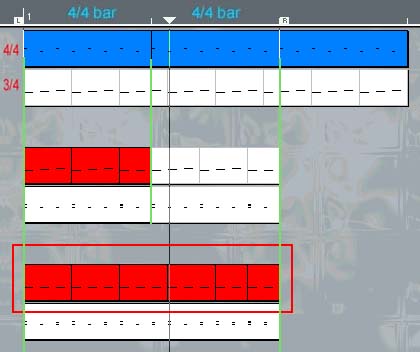
See in this image the highlite in RED rectangle?..... see how we now count longer before the resolve?.. We now count not 2 x 3 followed by 2 beats, but instead 4 x 3 followed by 4 beats which = 16 beats....
Now set the Time-Signature & metronome back to 3/8, & with all other tracks Muted, run Track_5, (5 - 3/8 synth resolve @ 16) & Track_6, (6 - 3/8 drum resolve @ 16)
Now resolving at double the length of 4/4 bars, our 3-time pattern is singing: 1,2,3, 1,2,3, 1,2,3, 1,2,3, 1,2, 1,2 = 16 beats... hmm... That's a double-up, But why is it ending with 4 beats??.... Well we have 4 beats spare at the end when working in 3-time & resolving at 16... so we could add another bar of 3/8, and hang a single beat on the end before going back to the beggining??... No, it doen't feel right, but adding a '1,2 1,2' at the end keeps the same feel as for the shorter pattern (1,2,3, 1,2,3, 1,2).
ok play it on the sequencer and listen.... again, switch the metronome between 4/4, 4/8 and 3/8 time and listen to it relative to the drums and bassline playing... Switch the metronome in and out too....
The beat on Track_6, (6 - 3/8 drum resolve @ 16) now puts a kik on each first starting beat of the 3/8 bassline on Track_5, (5 - 3/8 synth resolve @ 16, and a 4 beat riff at the end to copy the 3/8 bassline resolving at 16 beats: 1,2,3, 1,2,3, 1,2,3, 1,2,3, 1,2 1,2
Ok... Now stop it playing, and set the Time-Signature back to 4/4 and then copy over the parts on Track_3 & Track_4... like this...
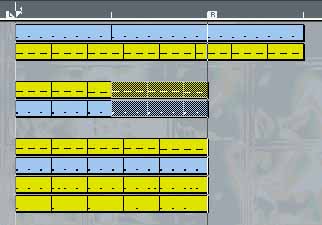
Now open up Track_4 which you just copied it's part on, so that it plays along with Track_5 & Track_6 .... try popping up the tempo to 170-180 bpm....
Voila!... Dancehall, jungle, drum & bass etc push up the tempo to 180... heh heh - ok so basically your merge those 16 & 8 resolves of 3-time over blocks of 4/4 and work on the grid in 8th's utilising beats and creating in a 3-time grid over 4/4 bar length devision chunks.... close your eyes and imagine a basic Amen break playing that pattern... Jungle.. whatever... 3's & 4's...
RnB beats & garage crossover feels - (Track_7 & 8)
ok... it's all in there, only this time our kik & snare beats can vary alot.. listening and flipping between the 4/4 or 4/8 based backbeat, and the 3/8 overlay gives access to the fast complexed grooves and feels of contemporary RnB & garage & breaks crossovers as well as quite a bit of two step... ok here we go...
This time we start with a 3/8 16th resolving pattern... the key to this thing is also to work in two different BPM times... double the time and also layer the 3/8... so we are running up an RnB sorta beat so set the tempo first back down to 130BPM.. don't worry.. what we are going to do will run at various tempo's and adapt in with whatever is using that tempo in that roundabout genre from hip-hop thu RnB and whatever crossovers... we can mess with that later... seeing it & hearing at a slower tempo is easier to see at first... so set the tempo to 120 or 130 or so....
Now switch off all the tracks and the L/R Loop marker should still be set to 2 bars of 4/4 - we are now working on Track_7 & Track_8 highlighted in the red rectangle...
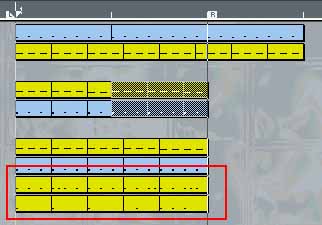
Then set the Time-Signature & metronome at 3/8... so it looks like this...

Hit play... Track_7, (7 - 3/8 hat resolve @ 16), is a shuffling hat beat simply made of a row of 16th notes, emphasising the 3/8 feel with some shuffles acheived by placing a few odd notes in between 8th's to make little rolling triplets... Double click and open the music parts on Track_7 in your editor...
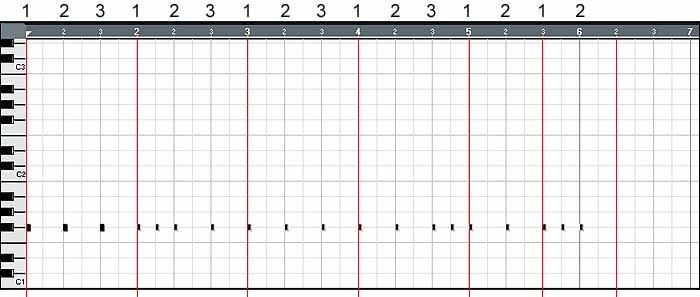
simple eh! and easy to follow on the drum grid when you are looking at a 3/8 grid and listening to a 3-time 3/8 metronome... All it is is 3 notes evenly apart for each chunk of 3 beats... at a few points as noted, there is some notes placed in between the ones on the 3 count... all you gotta do now is add velocity to emphasis the 3-time feel by making the beat_1 of each bar of 3 beats a bit louder as well as emphasising the ONE of the pair of 2's at the end...
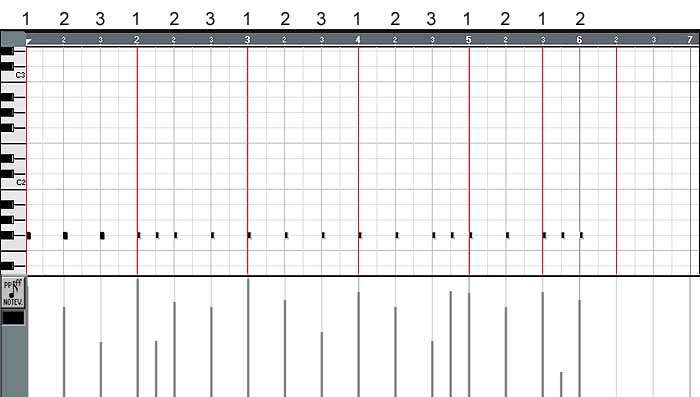
Now try changing the Time-Signature to 4/4 while the hat-pattern is still running and also the mtronome.... listening to the hat pattern over a 4/4 metronome is quite hard to tell how the pattern is composed... It is perhaps easier to get the feel of it especialy the velocity emphasis when everything is set back to 3/8...
Ok... Now turn that Hat pattern Track off (Track_7), and keeping the metronome on, set to 3/8 again, switch on Track_8, (8 - 3/8 beat resolve @ 16), which is the backbeat...
Again looking at the grid in your editor... and listening to the metronome over the beat it is easy to see how it come about as the first 3 drum beats are all dead on the start of the first beat of the first three bars, followed by an offbeat in bar 4 and a final 4 beat fill to match the last 4 resolving beats for a 16 beat length groove.

Switch the Track_5, (5 - 3/8 synth resolve @ 16), synth-bassline on again... and see how the kik & snare beat follows it around... ok.. now switch off the synthline (Track_5), and switch on the Track_7 hat pattern again so it's playing with the backbeat...
This kinda technique works at tons of tempo's so try messing with the tempo between 130 and 180... whatever... But again this two themes of working at two tempo's and two time-signatures works for all styles...
TRANCE & TECHNO STYLES ???
Well, next time... here ends part_1 of this two part Article... Part_2 will cover more stuff about triplet & 3/8 & 3/16 & 4/16 patterns with some idea's about how to utilise layered toime-signatures & tempo's to get stuff for techno/trance etc styles... but this should give you some idea's and you should be able to discover all sorts of things...
COMMENTS FOR:
'Grooves & Patterns 1'There are a total: 34 comments posted to this page.
Name: Kelly
Email:
Activity:
Date: 05-Oct-01
Nice article...good primer. You guys are a wonderful resource for folkses like myself just starting to make music w/ computers.
| Article rating out of 5: |
Article 'ratings' were added September 2008, so most articles have no viewer rating
Name: herbert
Email:
Activity: part-timer
Date: 05-Oct-01
there is a lot of western music in 3/4 time. originally this was called the perfect meter, for religious reasons, representing father, son and the holy ghost. 4/4 was the imperfect meter. there was also a lot of dance-music in 3/4 time, just take a look at tielman susato's danserye from 1551. in baroque suites you can find a lot of 3/4 stuff - courante, sarabande, gigue, minuet, etc. and just think of the waltz. although it is true, that most charts-stuff is in 4/4, i would not say that "... in the west we are brought up on a diet of music done in 4 & 2 time ..."
| Article rating out of 5: |
Article 'ratings' were added September 2008, so most articles have no viewer rating
Name: Bastiaan (hajee)
Email:
Activity:
Date: 05-Oct-01
that 'Golden-Brown' is one good exeption to the 4/4 rule...nice article.
| Article rating out of 5: |
Article 'ratings' were added September 2008, so most articles have no viewer rating
Name: A.mann
Email:
Activity: Hobby-ist
Date: 10-Oct-01
great artical! You,ve helped explain in very simple and clear terms what I already sorta knew (felt) and brought it all together in an easy to understand nutshell. very cool. Thanks.P.S. I am a complete newbie to the internet. is it possible to down load this ,as well as other articals found on your site ,for future referance or will each artical be arcived within your site for easy referance at any time? thanks again, I could really use a site like this to help clear up alot of questions I have had on various topics in this feild and to keep me updated. good job keep it up. and see you next artical. Cant wait.
| Article rating out of 5: |
Article 'ratings' were added September 2008, so most articles have no viewer rating
Name: Kim Andre Vingan
Email:
Activity: Hobby-ist
Date: 05-Nov-01
i dont now
| Article rating out of 5: |
Article 'ratings' were added September 2008, so most articles have no viewer rating
Name: adrian
Email:
Activity: Hobby-ist
Date: 14-Nov-01
this is very good and easy to care
| Article rating out of 5: |
Article 'ratings' were added September 2008, so most articles have no viewer rating
Name: Dij
Email:
Website?: don't have one yet,sorry...
Activity: Hobby-ist
Date: 20-Nov-01
That was a very informative article. I have quite an extensive music practical and theoretical education and have over the last couple of years extended this to the technological world.
I found your article very useful.
| Article rating out of 5: |
Article 'ratings' were added September 2008, so most articles have no viewer rating
Name: judo
Email:
Website?: confidential
Activity: Professional
Date: 26-Nov-01
Quite an interesting page, it attempts to establish a purpose, or meaning but does neither. I was hoping to see what free ware you had but it appears that you have none, and basic knowledge of beatmapping software is not present. Keep working maybe you'll get somewhere.
| Article rating out of 5: |
Article 'ratings' were added September 2008, so most articles have no viewer rating
Name: SOBONGILE BALLANTYNE
Email:
Website?: grooves & patterns
Activity: Hobby-ist
Date: 03-Dec-01
THIS DID NOT GIEVE ME THE INFORMATION THAT I NEEDED I WANTED TO KNOW MORE INFORMATION ABOOUT THE BEGGING AND TIME OF REGGEA MUSIC.
| Article rating out of 5: |
Article 'ratings' were added September 2008, so most articles have no viewer rating
Name: lyday
Email:
Activity: Hobby-ist
Date: 04-Dec-01
This article was a good introduction to the differant types of patterns of various music styles. All the people complaining about this article are showing their ass. They obviously forgot that this article was for beginners and was an introduction of later more in depth articles. The article is about the basics which is what most idiots never cover; they just want to learn something fast and easy.
The idiot a couple of messages up who says that this article doesn't establish a meaning and a pupose is completely wrong. He's just trying to sound like he knows what he's talking about. God, people like him annoy the crap out of me. This article's pupose was to explain the different styles of arranging beats (not just house, breaks, DrumNBass). It did exactly what it set out to do. It explained the basics. This website has been one of my resources that helped me get out of a hardware based setup to a PC based set up. No this page doesn't post information every day but when it does post information it is quite helpful. SO all you guys barking at this site need to think what's really going on b4 you start spouting.
| Article rating out of 5: |
Article 'ratings' were added September 2008, so most articles have no viewer rating
Name: rsmash
Email:
Website?: none
Activity: Hobby-ist
Date: 06-Dec-01
Yep, great article!
I've been only recently starting to fiddle with other signatures. This gives me a good way to look at it and clear out a bit of the path.
Great stuff, hooked me up to the site !
| Article rating out of 5: |
Article 'ratings' were added September 2008, so most articles have no viewer rating
Name: BYN
Email:
Activity: Hobby-ist
Date: 10-Dec-01
very nice article im in to hip hop and most beats seem to be made in different time signatures so this opens up my eyes a bit to whats really going on good lookin out
| Article rating out of 5: |
Article 'ratings' were added September 2008, so most articles have no viewer rating
Name: author
Email:
Activity: Professional
Date: 20-Dec-01
well reggea... there is various classic grooves - old Roots radic triplet feels is simply: 123, 123, 123, 123, 123, 123, 123, 123 - = 8 beats
Tapper Zukie's MPLA (stepper classic) is based on 3/8 - 123,123,12,123,123,12
Peanut vendor riddim is based on a triplet 123 coming BEFORE the first kik which is offset back coming in on the 3rd triplet hat beat...
ska beat is 8 beats of 3 time 123,123,12 with a swing cos ska bands were copying swing bands in the 50's but with their own cultural 3 time feel
| Article rating out of 5: |
Article 'ratings' were added September 2008, so most articles have no viewer rating
Name: ilan
Email:
Activity: part-timer
Date: 23-Dec-01
I thought that was an excellent article.
| Article rating out of 5: |
Article 'ratings' were added September 2008, so most articles have no viewer rating
Name: Alex Smith
Email:
Website?: http://www.cynicmusic.com
Activity: part-timer
Date: 14-Jan-02
I came here looking for porn, but found none. Therefore this article sucks! hehehe just kidding, great work and very informative.
| Article rating out of 5: |
Article 'ratings' were added September 2008, so most articles have no viewer rating
Name: Stefan
Email:
Website?: www.light-housestudios.com
Activity: Hobby-ist
Date: 18-Jan-02
This is just the kind of article I have been looking for since I started! Totally helped take out the stiffness in my beats yet I can take it alot of places. I really appreciate the BASE as opposed to one specific recipe approach and agree that most articles are just how to do what ever is on the page. THANK YOU PLEASE WRITE MORE.
| Article rating out of 5: |
Article 'ratings' were added September 2008, so most articles have no viewer rating
Name: Witheld
Email:
Website?: mine
Activity:
Date: 18-Jan-02
Judo is a prick. See his comment above This article RULES!!! It is truely useful.
| Article rating out of 5: |
Article 'ratings' were added September 2008, so most articles have no viewer rating
Name: dude
Email:
Website?: none
Activity: Hobby-ist
Date: 29-Mar-02
i thought this atricle was awesome as i have didnt actually know about timing but could do all the other stuff to make songs. hence i have now made some drum and bass tunes which i really like and rate.
COULD WHOEVER WROTE THIS PLEASE WRITE THE PROMISED SECOND ONE THAT I DONT THINK EVER GOT WROTE OR PUT UP HERE. THANKS:)
| Article rating out of 5: |
Article 'ratings' were added September 2008, so most articles have no viewer rating
Name: bUttA
Email:
Activity: part-timer
Date: 04-Apr-02
Definately a good read just like the other articles on this website!
I hope article 2 of this series gets publised soon.
| Article rating out of 5: |
Article 'ratings' were added September 2008, so most articles have no viewer rating
Name: Vadim
Email:
Website?: www.mp3.com/subtleproduction
Activity: part-timer
Date: 10-May-02
Very important stuff in this article! I really found many things that cleared my questions about 4/8 and 3/8 forms... When is part_2 coming out?
| Article rating out of 5: |
Article 'ratings' were added September 2008, so most articles have no viewer rating
Name: splarp
Email:
Activity: Hobby-ist
Date: 12-May-02
Very interesting and helpful article. Part Two in the not tooooo distant future would be good. : )
regards,
| Article rating out of 5: |
Article 'ratings' were added September 2008, so most articles have no viewer rating
Name: peter
Email:
Activity: part-timer
Date: 11-Dec-02
hi!
some of the jpeg's couldn't be viewed on this page!
could you please update the links and tell me when it's done?
btw, great mag and yes, more articels with logic and groove&drum programming please!
thanks alot and best regards from germany
peter
| Article rating out of 5: |
Article 'ratings' were added September 2008, so most articles have no viewer rating
Name: alen p.
Email:
Website?: no
Activity: Hobby-ist
Date: 02-Jan-04
very good. please can you tell me where the second part is or who the author is.
i would like to read more.
you can give him my address.
| Article rating out of 5: |
Article 'ratings' were added September 2008, so most articles have no viewer rating
Name: foni
Email:
Website?: none
Activity: Professional
Date: 06-Sep-05
i can see a OLD CUBASE .can you tell me?das a TIMBALAND use CUBASE still? or what he use?LOGIC PRO TOOLS .thank you
| Article rating out of 5: |
Article 'ratings' were added September 2008, so most articles have no viewer rating
Name: dj darkstyle
Email:
Activity: part-timer
Date: 22-Jan-06
(I program mainly dnb & have had no formal musical education) I didnt really understand the article, not because im stupid (believe me im not) but because its never really explained what 4/4 or 3/4 timing IS. And i use fruity loops so its hard to follow the pictures. I dont have any problems programming drums, I just really wanted to understand the history and logic(?) behind it, so if someone could help explain id be very grateful. (p.s. judo & foni are dicks)
| Article rating out of 5: |
Article 'ratings' were added September 2008, so most articles have no viewer rating
Name: jack
Email:
Website?: http://www.dancefloor.com/rock/pinkfl.html
Activity: Professional
Date: 24-Jul-06
http://www.dancefloor.com/ROCK/pinkfl.html
Pink Floyds Money is in 7/8, Wish you Were Here is in 12/3.
only most people dont realize it or dont know how to count ... offbeat is the natural ingredient
of 3/3.
3/3 music is dance music 4/4 music is trance music - brain music ... music its connected to body
AND mind.
3/3 music is body music 4/4 music is mind music ...
PINK FLOYD:
http://www.dancefloor.com/ROCK/pinkfl.html
| Article rating out of 5: |
Article 'ratings' were added September 2008, so most articles have no viewer rating
Name: http://www.dancetech.com/aa_dt_new/artic
Email:
Website?: http://www.dancefloor.com/rock/pinkfl.html
Activity: Professional
Date: 24-Jul-06
Pink Floyds Money is in 7/8, Wish you Were Here is in 12/3.
only most people dont realize it or dont know how to count ... offbeat is the natural ingredient
of 3/3.
3/3 music is dance music 4/4 music is trance music - brain music ... music its connected to body
AND mind.
3/3 music is body music 4/4 music is mind music ...
PINK FLOYD:
http://www.dancefloor.com/ROCK/pinkfl.html
| Article rating out of 5: |
Article 'ratings' were added September 2008, so most articles have no viewer rating
Name: jens
Email:
Activity: Hobby-ist
Date: 04-Jul-07
Thats so exatly what i needed!!!!
Please write the 2nd Part, please!
Thats the jumping point for me this time. I know that all these things are there but i dont understand the relationship between them...
THAN YOU for that great input! More of this!
| Article rating out of 5: |
Article 'ratings' were added September 2008, so most articles have no viewer rating
Name: jens 2nd time
Email:
Website?: -
Activity: Hobby-ist
Date: 04-Jul-07
or give me some tips for easy understanding books with this term. :-)
| Article rating out of 5: |
Article 'ratings' were added September 2008, so most articles have no viewer rating
Name: Nevermind
Email:
Website?: -
Activity: Professional
Date: 03-Feb-09
This is a question for Jack,
3/3 time? what do you mean? Three what notes per bar? I am confused?????
What I mean is...
3/4 means three quarter notes per bar
6/8 means 6 eigth notes per bar
3/3 means 3 ? notes per bar
Are you meaning some kind of metric poroprtion? dose the second 3 relate to a triplet?
in other words are you meaning
3/3 means 3 triplets per bar?
I am confused and interested as to what you mean by 3/3.......
| Article rating out of 5: |
Article 'ratings' were added September 2008, so most articles have no viewer rating
Name: Jon F
Email:
Activity: part-timer
Date: 10-Aug-10
can somebody get the link working for the midi file?
| Article rating out of 5: |
Article 'ratings' were added September 2008, so most articles have no viewer rating
Name: admin
Email:
Activity: Professional
Date: 11-Aug-10
Sorry about that. it's now fixed
| Article rating out of 5: |
Article 'ratings' were added September 2008, so most articles have no viewer rating
Name: Yo!
Email:
Activity: part-timer
Date: 11-Aug-10
COULD WHOEVER WROTE THIS PLEASE WRITE THE PROMISED SECOND ONE THAT I DONT THINK EVER GOT
WROTE OR PUT UP HERE. THANKS:)... I second this comment! - great article.. where's the second? cheers
| Article rating out of 5: |
Article 'ratings' were added September 2008, so most articles have no viewer rating
Last added comment
Name: leigh
Email:
Activity: part-timer
Date: 10-Sep-11
great resource
am working at it
thanks
| Article rating out of 5: |
Article 'ratings' were added September 2008, so most articles have no viewer rating
'Grooves & Patterns 1'
Note: To cut down on spammers, cookies must be enabled to post comments to this page.
[back to top]